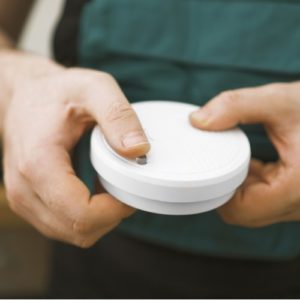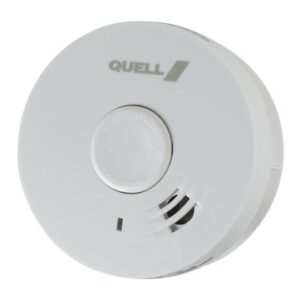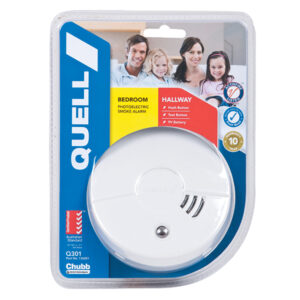We scoured industry research, ratings, and reviews to bring you the best smoke detectors.
Best smoke detectors
SafeWise experts have years of firsthand experience testing the products we recommend. Learn how we test and review.
It’s easy to forget your smoke alarm’s there until it starts beeping or chirping. But while we take them for granted, they’re always keeping tabs on fire safety.
Our top pick Google Nest Protect is expensive, but all its extras make it worth the price. It offers remote notifications, a light, voice notifications, and more.
The best smoke detectors
- : Best smoke detector overall
- : Best budget smoke detector
- : Best interconnected smoke alarm

1. Google Nest Protect: Best smoke alarm overall
The Google Nest Protect keeps your home protected in more ways than one. Sure, it can detect smoke, but with its split-spectrum sensor, it detects smoldering fires as well as fires with active flames. It also detects carbon monoxide with an electrochemical sensor.
When a smoke or carbon monoxide detector is triggered, the Nest Protect will flash its built-in light, sound an alarm, and use voice alerts to let you know exactly what type of emergency it's detecting. It also sends alerts to your phone through the app.
The drawback is it's expensive for a fire alarm. Still, the benefits are worth the price, especially if you have a smaller home that doesn't need too many smoke detectors. If you're on a budget, it's better to opt for the next pick.
For more information, read our full Nest Protect review.
2. Quell Photoeletric: Best budget smoke alarm
If you're looking for a bare-bones smoke detector that does what it says on the tin and nothing else, the budget-friendly Quell Photoelectric Smoke Alarm is for you.
It's good quality and affordable enough that you could comfortably kit out your whole home without forking out too much cash.
3. LEVSUPTY: Best interconnected smoke alarm
In Queensland, all properties are legally required to have interconnected photoelectric smoke alarms. Even for non-Queenslanders, interconnected smoke alarms are the safest choice. This five-pack from LEVSUPTY is good value, reliable, and can connect up to 50 alarms for total coverage of your home.
We also like that these detectors are wirelessly interconnectable, meaning no electrician is required for installation.
Interconnected smoke alarms are alarms that connect to one another in a dwelling either directly or wirelessly, and when one detects smoke, all alarms in the home are triggered. They're the safest choice as they make it more likely that everyone in the dwelling will be notified and able to evacuate.
Smoke alarm requirements per state and territory
Though smoke alarms are required in every dwelling across Australia, each state and territory has its own laws regarding the type and number of smoke alarms necessary.
Here's a quick breakdown of the requirements around the country.
In New South Wales, smoke alarms must be installed on every level of a residence. That includes occupied homes, rental properties, caravans, campervans and any other building where people sleep.
Smoke alarms must be placed in hallways near bedrooms, but if bedrooms are located far from each other, one must be installed near each of those locations.
In Queensland, all smoke alarms must be photoelectric, interconnectable, less than 10 years old, and in working order.
Smoke alarms must be installed on every storey, in every bedroom, as well as hallways connecting bedrooms to the rest of the home. If there are no bedrooms on a storey, the smoke alarm must be placed in the most likely path of travel to the exit.
In Victoria, every residential property must have smoke alarms installed on every level.
Interconnected smoke alarms, though not required, are highly recommended for the best protection.
All homes in South Australia are required to have at least one hard-wired smoke alarm installed. In dwellings not connected to power supplies, smoke alarms powered by 10-year non-replaceable, non-removeable batteries are also permitted for use.
From 1 May 2014, any new building (or existing building with a new extension or addition) must install interconnected smoke alarms.
In Western Australia, mains-powered smoke alarms must be installed in all hallways leading to bedrooms (on every storey that contains one) and, where there is no hallway, an area near the bedrooms.
As of 2022, every home in Tasmania must have a smoke alarm (either mains-powered or powered by a 10-year, non-removable battery) in every corridor associated with a bedroom. There must be at least one smoke alarm installed on each storey, even if it does not contain a bedroom. All smoke alarms must be tested by the first day of a new tenancy and kept in working order.
All residential properties (including movable dwellings) in the Northern Territory are required to have a working smoke alarm. As of 2011, any new smoke alarm installed must be photoelectric.
In the ACT, smoke alarms must be installed on each storey of a building. For storeys that contain bedrooms, the alarm is to be placed between the bedroom and the rest of the building (i.e. a hallway). Smoke alarms may be hardwired or battery operated, however ACT Fire & Rescue recommend hard-wired, interconnected photoelectric smoke alarms only.
Final word
Even though it's on the expensive side, we picked the Google Nest Protect as the best smoke detector because it's just so darn helpful. Beyond being able to detect carbon monoxide and different types of fires, the app removes the frustration that comes with typical fire alarms.
How we reviewed the best smoke detectors
To determine the best smoke alarms, we scoured industry research and evaluated product features, performance, and specs. We also pored over expert ratings and real customer reviews.
Our four best smoke alarms were selected from dozens of devices that were compared for reliability, effectiveness, price, and customer satisfaction. Learn more about how we conduct reviews like this one from our methodology page.





